WELL ART - Jessica Ostrowicz on art that provides shelter. "I started building a symbolic roof over my head."

The exhibition "Persisting Without Return" in Wrocław is Jessica Ostrowicz's first solo presentation in Poland – and an incredibly personal story about memory, identity, and the search for refuge. In a conversation with the artist, we delve into the depths of her creative process, where matter becomes a vehicle for emotion and a tool for healing multigenerational trauma. We learn what home means and why art should be accessible to all.
On July 16th, the exhibition " Persisting Without Return " premiered—the first solo presentation of Jessica Ostrowicz's work in Poland. An hour before the official opening, before the first viewers even entered OP ENHEIM , I had the chance—and the good fortune—to speak with the artist, Jessica , and the exhibition curator, Philine Pahnke .
We met at the heart of the exhibition , which, from the first glance, looked as if it had always existed there. It was as if the building's historic interior and the artist's personal experiences lived in a subtle symbiosis. Philine pointed the way, revealing the layers of the exhibition , and Jessica spoke calmly, with the tenderness and sincerity that emerges when the conversation touches on something truly important.
We stopped at eggshells, nests woven from hair, fragments of pipes – small objects that, in this space, took on the weight of monuments. Each of these objects – as if whispering – about a home that no longer exists, about a difficult family history and the struggle to overcome the trauma of the past.
 Guided tour during the opening of the exhibition "Persisting Without Return" by Jessica Ostrowicz / photo: Wojciech Chrubasik
Guided tour during the opening of the exhibition "Persisting Without Return" by Jessica Ostrowicz / photo: Wojciech ChrubasikAngelika Lachawiec Well.pl : How did your adventure with art begin? Did you always feel it would be your form of self-expression?
Jessica Ostrowicz: I've always been a creative artist. I loved drawing since I was two or three years old. At some point, I simply told my family I wanted to be an artist—and I've been on that path ever since. I studied art for eight years, and after graduation, I constantly strived to become a full-time artist.
Your art is deeply personal—you grew up knowing only a fragment of your family history related to the Holocaust. The truth about your grandfather's Jewish roots only came to light after his death. How did it feel to discover such a crucial part of your identity? Did it influence your work?
I knew that part of my family was of Jewish descent, and I even attended Jewish elementary school, but I thought it only affected one "branch" of my family. Only later did I discover the full truth. I believe this mystery inspired my work. It's familial and cultural narratives—how we tell the story of who we are—that influence our perception of reality.
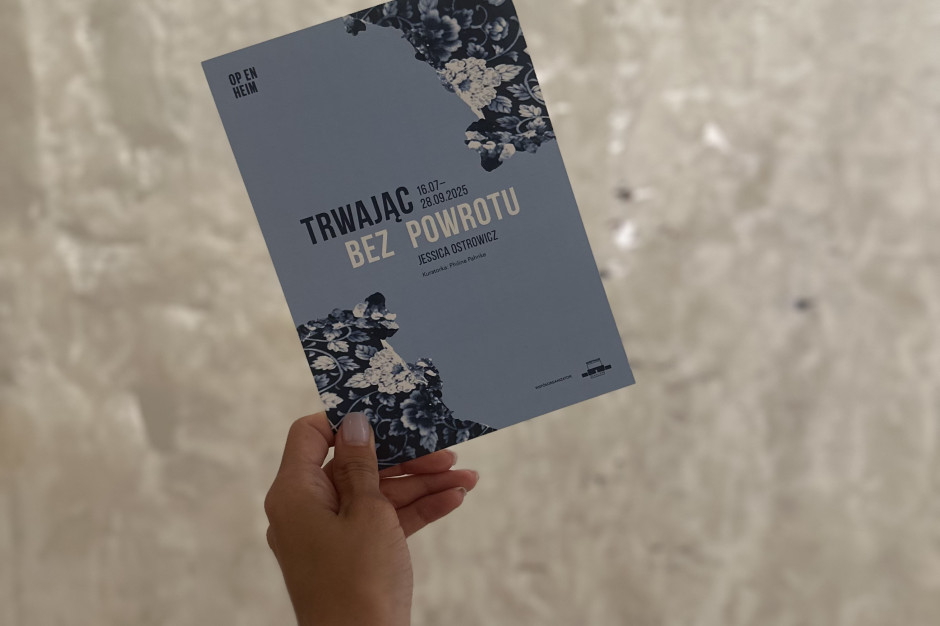 The exhibition "Persisting Without Return" by Jessica Ostrowicz at Op Enheim in Wrocław / photo: Well.pl editorial team
The exhibition "Persisting Without Return" by Jessica Ostrowicz at Op Enheim in Wrocław / photo: Well.pl editorial teamWhat exactly has changed?
We often process experiences by repressing them. We want to move forward by forgetting the past, but that's impossible. If we want to process trauma, we must first examine what has been hidden. We must "enter" this painful process and dismantle everything. Only then can we begin to put everything back together and heal the wounds in our own way.
Was art your way?
Yes. My situation here is quite unique. Often, it's the second or third generation that truly feels the trauma they inherit. The first generation experiences the trauma, their children empathize with it, and the next generation—like me—can distance themselves enough from it to truly see it. I feel this history within me, but I can confront it, I can begin to change things. People often think of trauma as something we simply inherit and that's it. But if we can pass on pain and suffering, we can also pass on something good. Transformation is possible.
It's true that from a distance, it's easier to see the traces left by trauma. The theme of "home" also frequently appears in your designs. What does "home" mean to you today?
As children, we often have an idealistic idea of what home is – a place of warmth, security, and stability. But as we grow older, everything becomes more complicated, because home is not just a building, but above all, relationships – and these become increasingly complex over time. At some point, we must reorganize our thoughts and feelings about childhood and family. Then we truly begin to understand what home means to us. For me, this takes on an additional dimension, as I come from a family that, for generations, was forced to move, and sometimes flee. For me, home is a collection of memories, relationships, and emotions. It's also a sense of security. The meaning of home took on a new dimension for me when I started working in prisons. It's a place you can hardly call home, yet a large group of people live there. Despite this, inmates try to create at least a semblance of home there.
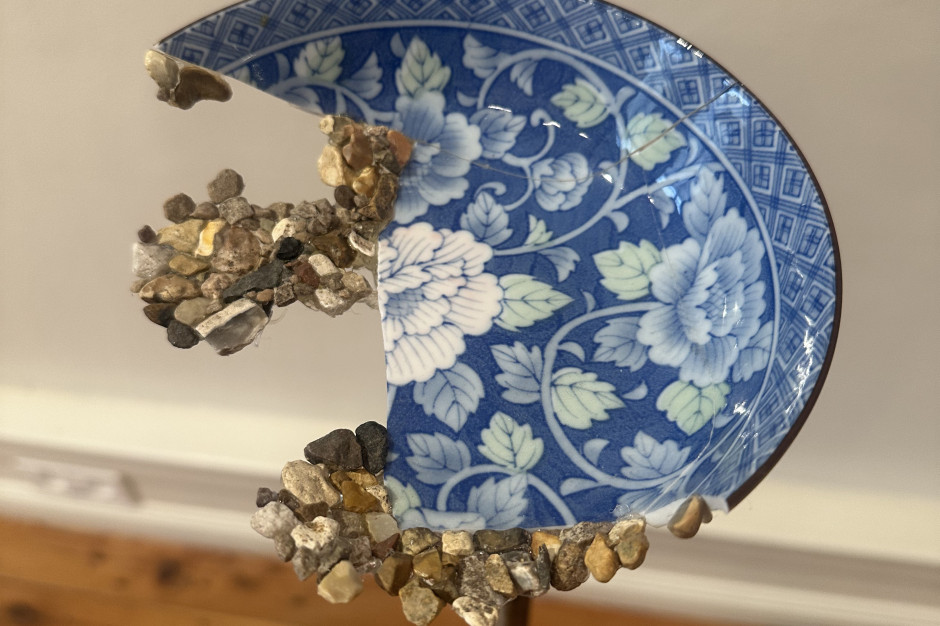 The exhibition "Persisting Without Return" by Jessica Ostrowicz at Op Enheim in Wrocław / photo: Well.pl editorial team
The exhibition "Persisting Without Return" by Jessica Ostrowicz at Op Enheim in Wrocław / photo: Well.pl editorial teamYour exhibition at OP ENHEIM is your first solo presentation in Poland – and in such a unique place, which for years was an important center of Jewish community life in Wrocław. Were you aware of this history when choosing the space?
Absolutely not! It was a perfect, almost magical coincidence! Only later did I begin to delve into the history of the building. Today, I can say that an almost symbiotic relationship has developed between my work and the history and "life" of the building itself. This space, in a sense, celebrates its history—through tiny cracks, through creaking floors. When Philine and I were working on the final shape of the exhibition, we made sure that the smallest elements were tailored to the space. I feel that this space is a participant in the exhibition.
The new face of art according to Jessica Ostrowicz: ceramics, hair, and eggshells instead of brushes and watercolorsInstead of traditional canvas, brushes, and paints, you use rather unusual and fragile materials like ceramics, hair, and eggshells. Where did this idea come from?
Today, many works of art are created using expensive materials, yet art should be widely accessible, so that everyone can create, regardless of their budget. Besides, I like it when at least one element in my work comes from home and is close to my heart. My work often features simple yet emotionally significant elements. The material I create with is very important to me, and if I don't have an emotional connection to it, I don't see the point in using it.
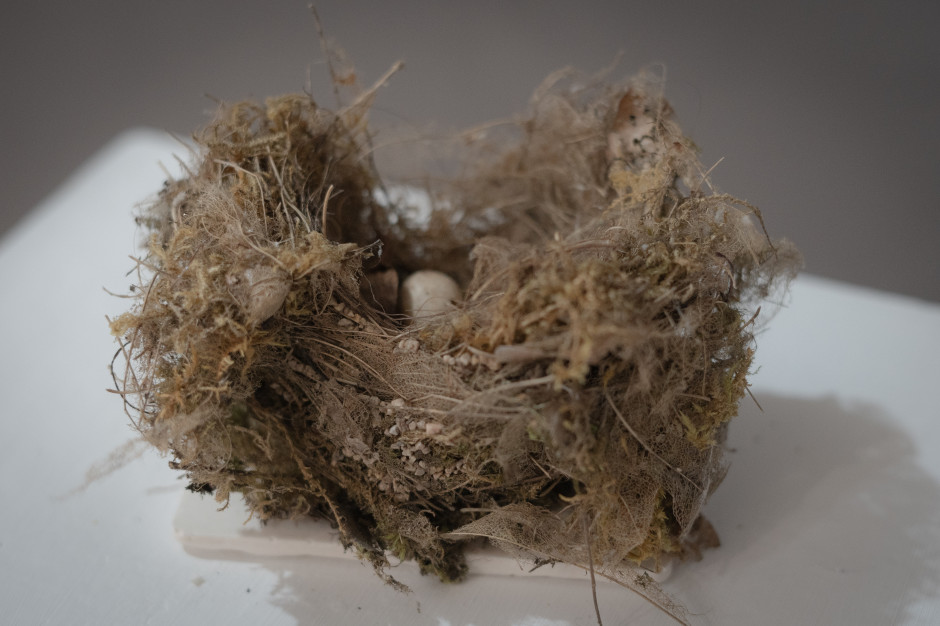 Nest, a work of art by Jessica Ostrowicz / press materials Op Enheim
Nest, a work of art by Jessica Ostrowicz / press materials Op EnheimAny particular example?
When I go for a walk, I collect eggshells and then "turn" them into a work of art—I create an interpretation of the egg on paper. It's fascinating that a bird's life begins in an egg. To be born, it must destroy its first home. It's beautiful and symbolic. Each eggshell I find tells a story about a specific place and moment. For example, this eggshell is from the day before my wedding, and I found this one the day after.
Jessika Ostrowicz on emotions in artSpeaking of emotions, is there a piece of art in the exhibition that particularly moves you or that you found difficult to work with?
There are many objects in the exhibition that are emotionally difficult for me. I think it's crucial to look at all the works holistically. They're a bit like chapters in a single story. Being in this space feels like standing in a room full of mirrors, reflecting different aspects of myself. Some of these works move me because of what they represent. Others because they took me years to create. Others were created in collaboration with other people.
So, which one moves you the most?
After my grandfather died, I started collecting nests. While tidying up his house, I found a bird's nest in the shed. It was woven from hair—I thought it might have belonged to my grandmother—and small objects from the garden. Inside the nest was a tiny egg. I thought it was a metaphor for the house, which was literally created from fragments of my grandparents' lives. So I decided to add something of my own. I placed small stones inside—the kind placed on graves in Jewish tradition as a sign of remembrance. It was my gesture of healing. In the same shed, I found a paper bag containing my great-grandmother's hair. From these, I made another nest, the one we see in the exhibition. This work is very important to me.
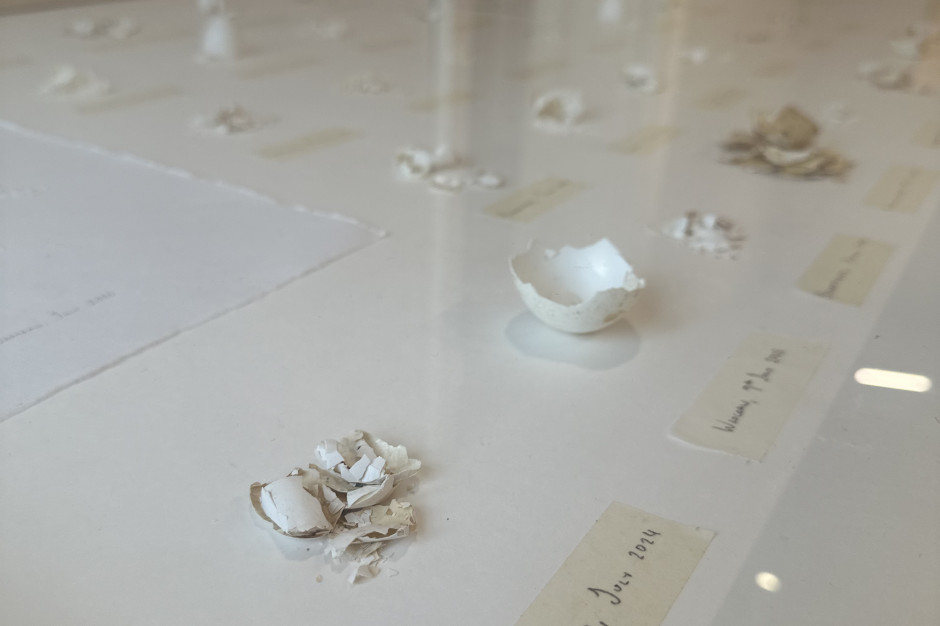 The exhibition "Persisting Without Return" by Jessica Ostrowicz at Op Enheim in Wrocław / photo: Well.pl editorial team
The exhibition "Persisting Without Return" by Jessica Ostrowicz at Op Enheim in Wrocław / photo: Well.pl editorial teamLooking at the exhibition, I have the impression that the motif of birds themselves is also familiar to you?
It's true! It wasn't until I started looking closely at my own work that I realized how often the motif of birds appears. They're delicate creatures that I love to observe—especially when they build their nests. When I watch a flock of birds, there's something hypnotic, even enchanting, about their movements. At the same time, there's something unsettling about it. This duality—the combination of fragility, wildness, and restlessness—makes birds incredibly fascinating to me.
And the piece you worked on the longest?
It's definitely "Exhaust Archive," which I've been working on for seven or eight years. I think it took me about 2,000 hours to create. It all started in London, when I was trying to find peace. At that time, I often walked along the Thames, and my attention began to be drawn to objects that washed ashore. Among them, I found thousands of fragments of smoking pipes. They seemed incredibly beautiful to me—they told people's stories. Some had fingerprints, engraved names, or flowers. What intrigued me was the possibility of determining their age!
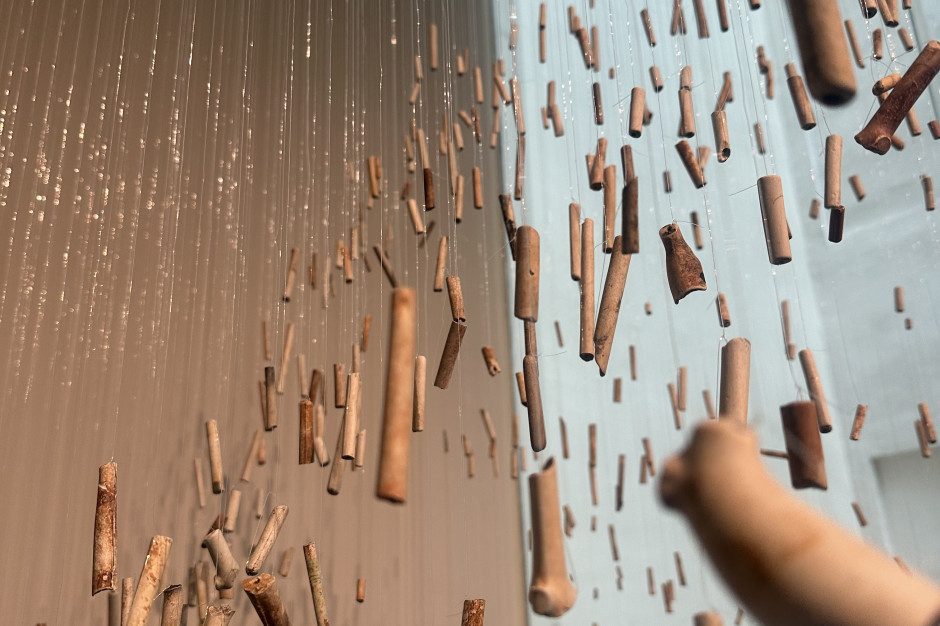 Exhaust archive, "Lasting Without Return", by Jessica Ostrowicz at Op Enheim in Wrocław / photo: Well.pl editorial team
Exhaust archive, "Lasting Without Return", by Jessica Ostrowicz at Op Enheim in Wrocław / photo: Well.pl editorial teamHow exactly?
Examining the bore diameter, the length of the pipe, or assessing the decorations. Each of these elements tells something about people about whom we will likely never learn anything more. I felt I wanted to connect with them in some way. I began collecting and archiving them. In total, I amassed a thousand pipes – each one photographed and carefully measured. I also began recording the sound of each pipe. The last action someone performed many, many years ago – sometimes as many as 600 years ago – was to inhale and exhale smoke through one of these pipes.
Jessika Ostrowicz on the role of the artist in the contemporary worldYou mentioned that art should be accessible regardless of budget. You collaborate with prisoners, poring over everyday objects, searching for stories and emotions within them. What do you think the role of an artist should be?
I don't feel like becoming an artist was a conscious decision. It wasn't like I went to university, studied art, and decided, "Now I'm going to be an artist." It's something that flows from me. I think art is important—especially in the context of places like prisons. I see how easily societies—especially those privileged to live in peace—divide the world into good and evil, us and them. In this framework, we "place" prisoners outside of society. Yet they create their own community, have their own relationships, their own ways of communicating and existing. In my work, I want to show this other perspective. At the same time, it's very easy to take a work out of prison, exhibit it, and say, "This is art created behind bars." But it's also important for culture to find its way into prisons. For a more porous membrane to exist between "society" and what we consider to be on the margins. It should be a dialogue, not a one-sided exchange.
If you had to use only one word to describe your exhibition, what would it be?
Shelter.
I didn't expect that. Can you explain?
Sure! It's not exactly a home in the traditional sense, but rather a space I've created for myself to feel safe. The trauma work is still ongoing, but in parallel, I've begun to build a symbolic roof over my head. Something that gives me a sense of refuge.
What would you like viewers to feel or understand when experiencing your art?
I think the themes I started with were very personal and strongly connected to my own experiences. Over time, however, they evolved into a broader reflection on the human need for a home. It's a need that's universal, though not always conscious. If what I create allows others to identify with it—if someone finds a part of themselves in it—then I'll be truly happy.
well.pl








